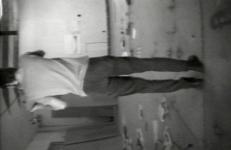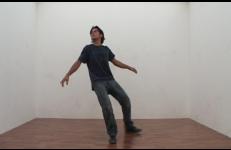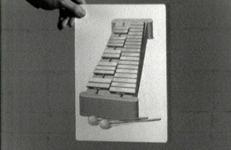In this now infamous tape, exemplary of his early transgressive performance style, Acconci sits and relates a masturbatory fantasy about a girl rubbing his legs under the table. Carrying on a rambling dialogue that shifts back and forth between the camera/spectator and himself, Acconci sexualizes the implicit contract between performer and viewer—the viewer serving as a voyeur who makes the performance possible by watching and completing the scene, believing the fantasy.
Conceptual Art
Nauman stands with his back to the camera, repeatetedly drawing the bow across the strings of a violin tuned D, E, A, D. Perhaps more than any other exercise, this tape demonstrates the sense of anticipation built up in the viewer, as we wait for Nauman to walk, to turn around, to play music ... to do something. This title was in the original Castelli-Sonnabend video art collection.
Danh Vo is a Vietnamese-born Danish conceptual artist, currently living and working between Berlin and Mexico City. His large installations often deal with issues of personal identity and belonging. In conversation with Norah Taylor, an art historian specializing in South and Southeast Asian art, Vo discusses his upbringing, career, and what led him to become an artist.
Making himself into a “minimalist” prop sculpture in the manner of Richard Serra, Nauman moves through various poses in realtion to the floor and wall. While other sculptors were using wood planks, pieces of lead, or sheets of steel, Nauman uses his body to explore the space of the room, turning it into a sort of yardstick to investigate and measure the dimensions of the space. This title was in the original Castelli-Sonnabend video art collection.
In this early black and white, reel-to-reel video, small game traps are set to catch the rain.
This title is also available on Sympathetic Vibrations: The Videoworks of Paul Kos.
An experiment in "video cubism." Two rows of three cylindrical water glasses are lined up to fit the frame of the monitor. The glasses disappear, then reappear; the action of placing them on the table is never seen. The glasses are filled with water with the image parallel to the picture plane; then again, with two cameras—one above and one straight on. Water Glasses investigates the psychology of perception—especially in relation to female identity—the video image, and the role of spectator.
Acconci explodes the notion of an artist’s creation, his creative act being the build-up and discharge of saliva, an activity more properly belonging to the realm of necessary and autonomic bodily functions than art. Positioning himself as a hyper self-conscious artistic subject, Acconci fuses the terrains of body art and process art, formulating the body as process, and art as a natural function of the body.
This title was in the original Castelli-Sonnabend video art collection.
“A spoof on current art attitudes [that] stretches the definition of what can be considered art. Because the late 1960s and early 1970s were periods of innovation, using the human body as art, making process equivalent to product... [etc.], Baldessari questions that very sense of originality and exploration by taking it to its (rather mundane) limits. By taping a stick at one end, then picking it up at the other, he is both questioning and spoofing what constitutes art.” —Marcia Tucker, “John Baldessari: Pursuing the Unpredictable,” John Baldessari (New York: New Museum, 1981)
Every country employs specific techniques for disguising its soldiers, every army has developed its own camouflage uniforms. Croatia is one of the few countries in the world that uses a digitized shape of its own territory in its camouflage military design. Why? The question is not meant to be answered by human reason. It does not relate to the perception of human eyes. Night vision cameras, binoculars, heat detectors and drones have their own ways of seeing the world.
white and fifteen movies starring Charlton Heston is a stroboscopic work made from fifteen films starring Charlton Heston. Each film has been algorithmically condensed down to thirty seconds in length. These fifteen condensed movies have been frame-by-frame chronologically organized and metrically inter-cut with two Heston film frames followed by two white frames.
There are times when concurrent multiple realities of place demand at least a simple attempt to determine who in fact has and where is this place in the sun. Hearts and Helicopters occurs at that moment in the lives of four people.
This title is also available on Lawrence Weiner: Hearts and Helicopters - A Trilogy.
A man is shot inside an empty room and he moves and takes on positions continuously out of center. The nature of the lack of balance is invisible and his ability to stand up in spite of unnatural postures is inexplicable: this videowork has been realized without special effects but is simply the result of a real shooting of an artificial condition.
Presenting a series of flashcards to the camera, Baldessari continues his exploration of visual semantics, defining the intersection of language and image. In this instance, each flashcard bears a picture that represents a letter of the alphabet. Like Teaching a Plant the Alphabet, a secondary theme of Xylophone is a critique of learning as memorization, with the length of the tape producing—not surprisingly—an effect of boredom rather than insight.
This title was in the original Castelli-Sonnabend video art collection.
















